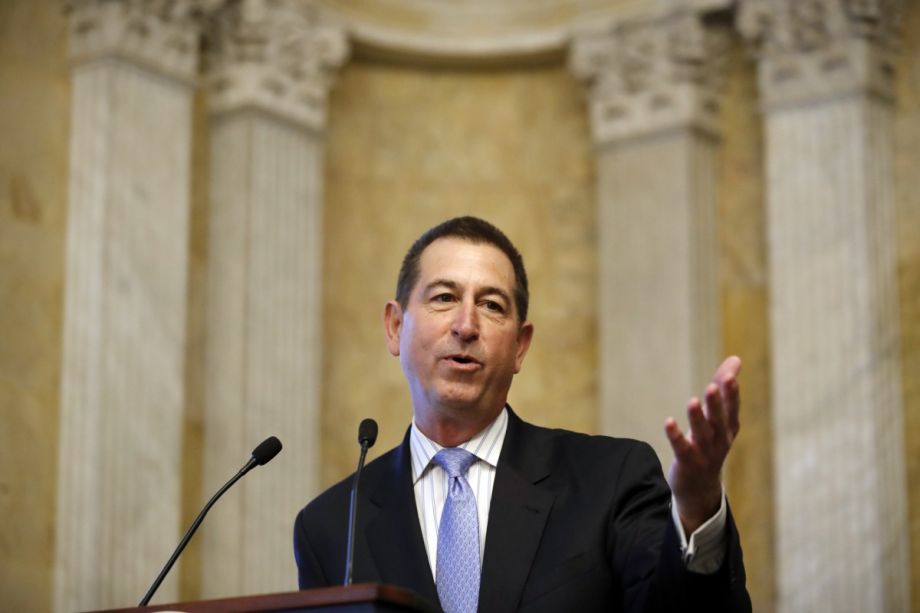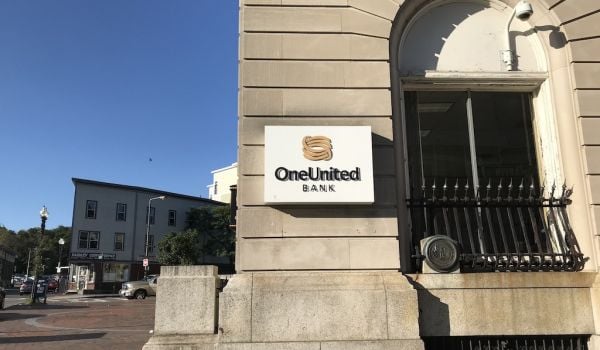On Wednesday last week, I hopped on a tour bus in “downtown” Jamaica, Queens, headed south along Guy R. Brewer Boulevard, a long corridor lined with barbershops and salons, pharmacies, and restaurants, serving some of the most diverse neighborhoods in the most diverse borough of arguably the most diverse city in the country. The primary guide on the tour was Hope Knight, president & CEO of the Greater Jamaica Development Corporation (GJDC) and currently a member of the City Planning Commission.
“There are a fair number of banks in the downtown but very few as you go south on Guy R. Brewer,” Knight said. “In some stretches you’ll see a check cashing shop on every corner, in a couple of cases you’ll also see check cashing locations co-located with pawn shops, a familiar sight on this route.”
Riding the bus were community organizers and advocates from around Queens and New York City, bankers, community development lenders, foundation staff, and federal bank regulators — including Joseph Otting, Comptroller of the Currency since November 2017. One of the main federal bank regulatory agencies along with the Federal Reserve and the Federal Deposit Insurance Corporation (FDIC), the Office of the Comptroller of the Currency (OCC) charters, regulates, and supervises all national banks and federal savings associations as well as federal branches and agencies of foreign banks.
The tour of Jamaica was organized by GJDC and the Association for Neighborhood and Housing Development (ANHD) — an umbrella group for nonprofit community development corporations and tenant organizations in New York City (GJDC is one of their members).
It was the fourth of a series of tours that Otting is taking this summer as part of a process with the stated goal of modernizing the Community Reinvestment Act (CRA), the 1977 law that says banks have a “continuing and affirmative obligation to help meet the credit needs of the local communities in which they are chartered,” including low- and moderate-income neighborhoods. Prior to last week, Otting had so far toured Atlanta, Baltimore, and Washington, D.C.
Otting’s predecessor, Thomas Curry, toured Jamaica in 2016. The area was ground zero for the 2008-2009 foreclosure crisis in New York, as black, Hispanic and immigrant neighborhoods across the country were disproportionately targeted with predatory subprime mortgage products.
The role of banks before, during and after the crisis was not a major topic of discussion for last week’s tour, though Otting himself is quite familiar with that role — before coming to the OCC, Otting was the CEO of a bank that recently settled a major redlining complaint with the Department of Housing and Urban Development. The complaint had to do with the bank’s conduct in the aftermath of the foreclosure crisis, during Otting’s tenure as CEO. Current Treasury Secretary Steve Mnuchin was also chair of that bank’s board of directors at the time the alleged redlining violations took place.
Before boarding the bus, Otting told the group how, on these tours so far this summer, he and his staff have met with community organizations, civil rights organizations, nonprofits and financial institutions, to talk about the direction his office is going with CRA “modernization.” He presented a viewpoint that the CRA is working mostly as intended, as measured by the dollars flowing into low- and moderate-income neighborhoods as a result of the law, but modernizing and streamlining enforcement could make it work better.
“The proof is in the pudding when you go into a community and see where those dollars end up,” Otting said.
Even if you have access to all the data that regulators currently collect, it’s hard to measure how many dollars are flowing to low- and moderate-income neighborhoods as a result of the CRA. Otting said his own staff spent a hundred hours going over their data to determine that banks are currently making around $480 billion dollars a year in home mortgage loans, small business loans and community development investments in low- and moderate-income neighborhoods, making them eligible for credit on banks’ CRA examinations, which are typically conducted every 3-5 years for each bank.
“We think banks can do more, with more clarity on what qualifies, more clarity on measurement,” he told the group before the tour.
Community advocates definitely agree that modernizing CRA regulations could make banks do more, but they tipped their hand showing some major disagreements with how to define and measure “more.” Otting expressed his intent to bring a focus on dollar amounts and transaction volumes, but community advocates expressed their concern that community engagement and process matter just as much as dollar signs and transactions when it comes to evaluating banks for their CRA obligations.
To illustrate this point, the tour stopped outside Northeastern Towers, where a new annex is nearing completion that will provide 159 units of affordable housing for seniors. The project combines some $95 million in public and private dollars, according to Jay Marcus, who briefed the tour group on behalf of Fifth Avenue Committee, a Brooklyn-based nonprofit community development corporation that is co-developing the project along with the Northeastern Conference of Seventh-day Adventists.
“CRA fosters and helps to create really makes these deals possible,” Marcus said. “But before deciding what to do we talked with the community board to get their input, and they told us they really wanted senior housing with services for seniors in the building, and shared laundry machines on each floor next to common areas to encourage social connections.”
“A site like this might be smaller, and smaller dollar amounts, but it’s high impact,” said Jaime Weisberg, senior campaign analyst at ANHD . “We want to make it clear that the CRA works best when banks understand the local context and respond with appropriate products and practices.”
Community dialogue should be the starting point for what banks should do as well as what banks shouldn’t do, community organizers stressed during the bus tour. Jamaica has become ground zero for another kind of crisis: larger developers using construction or neglecting maintenance to harass the neighborhood’s significant immigrant population to flip rent-stabilized buildings or taking advantage of non-native English speaking tenants to extract fraudulent fees of some kind. Banks that lend to developers like these can get credit under the CRA for loans to these developers if the buildings are in low- to moderate-income census tracts.
In March of this year, New York State Attorney General Letitia James filed a lawsuit against Zara Realty, which owns at least 2,500 rent-stabilized apartments in 38 buildings in the Jamaica area. The lawsuit accuses Zara of engaging “in an egregious pattern of tenant harassment and exploitation,” and “evading our rent regulation laws and forcing low-income tenants to pay exorbitant fees for fake services.”
“News outlets have covered what [Zara] has done, yet they continue to get loans to acquire buildings and supposedly renovate them,” said Jagpreet Singh, an organizer with Chhaya Community Development Corporation. “We see what the levels of speculation are doing in our community, displacing a lot of folks who have built up this community into what it is.”
Even with the recent rent regulation reforms passed at the state level, closing the loopholes that allowed and encouraged the flipping of rent-stabilized buildings, the landlords who deployed tactics to that end still own many of those buildings and stand to get CRA-eligible loans to acquire or renovate buildings.
In the post-tour question-and-answer session, community members pressed Otting on this issue of banks lending to landlords or developers who are known to use such tactics. Carmen Vega-Rivera, a tenant leader who has been dealing with this issue in her building in the Bronx, asked Otting if a bank could be penalized on a CRA examination for making such a loan.
Otting would not commit to a specific policy around such a practice, but did say a bank can be downgraded on a CRA examination “if their practices are deemed by the community to be unsatisfactory.”
Community engagement was built in to the CRA law. It says regulated financial institutions have a continuing and affirmative obligation to help meet the credit needs of the local communities in which they are chartered, but it doesn’t specify a process for determining those credit needs. The law empowered federal regulators to lay out that process, and over the decades both banks and community organizers have characterized regulations around the CRA as inefficient and inadequate.
While Otting did not express any antipathy on the day of the Jamaica tour toward community engagement, he has been dismissive of it in the past. Before and after the tour, Otting made note of the fact that during this process of modernizing CRA regulations and policies, his agency has received nearly 1,500 comments, of which 93 percent agreed CRA in its current context wasn’t working.
Greg Jost, director of organizing at the Bronx-based Banana Kelly Community Improvement Association, asked for a breakdown of how much of that 93 percent said there was too much community engagement versus too little. Otting did not offer a response to the question. He did, however, offer his view of CRA’s original intent, which reflected a more limited view of what the CRA means.
“In 1977, it was intended that financial institutions that have banking operations serve their local communities, with a focus that they didn’t take … deposits out of low to moderate income neighborhoods, and move those into other neighborhoods and didn’t do lending within those communities,” Otting said.
Jost offered a solution for so-called displacement financing in line with one of Otting’s key proposals. Clarity and predictability is one of the key issues Otting wants to address. Otting has heard from banks that they are often unsure whether a certain loan or investment will count on their next CRA exam, which may not be for another 3-5 years down the road. Otting envisions having a “CRA intake valve” at the OCC, the Federal Reserve and FDIC, where banks could submit projects at any time for CRA consideration and get a relatively quick response that the loan or investment will count on their next CRA exam. The applications and responses would be publicly available for comment from the community.
Jost asked that the “CRA intake” teams know to look for loans to predatory landlords to make sure that those loans do not count for CRA credit simply because the buildings are in low- to moderate-income neighborhoods.
“It isn’t an issue that we’ve had dialogue on amongst the three agencies so I obviously can’t make a commitment to that,” Otting said in reply. “But I do think that that is an issue across America that we’re dealing with, that we have the toggle between growth and development and and retaining communities for people who have lived there for a significant amount of years.”
Another issue that community advocates brought up was around small business lending. Currently, banks get credit for making loans to small businesses located in LMI census tracts that have annual revenues of less than $1 million. Otting has expressed a desire to raise this threshold, but advocates are concerned that doing so would make it harder to convince banks to make loans to small businesses in neighborhoods like Jamaica that are most in need of capital.
“Many of the businesses you see on Guy R. Brewer are businesses with revenues in low six figures, seeking capital in very small amounts,” Knight, of GJDC, said during the bus tour.
Across the entire borough of Queens, the average business — including large publicly traded companies — earns around $450,000, according to the latest available data from the U.S. Census Bureau. But the average masks significant disparities by race. The average white-owned business in Queens earns $368,000 in annual revenues while the average black-owned business in Queens earns $37,000 in annual revenues.
Otting said the $1 million small business CRA threshold was set in 1995, and if adjusted for inflation would be north of $2 million today.
“I do think probably in the end rule, that number will go up from a million I don’t know what will go up to now,” Otting said. “We amongst the agencies haven’t sat down and settled on a number, but it’ll probably be higher than what it is today.”
Otting said he expects the proposed final CRA regulations to be out for comment by November of this year, and most likely finalized by January 2020. In a departure from the norm, the OCC in 2017 initiated its CRA regulatory overhaul independent of the Federal Reserve and the FDIC. Otting says his agency has been in close dialogue with the other two. The Federal Reserve this year finally initiated some early conversations about CRA reform and a member of the Federal Reserve Board of Governors delivered remarks about CRA modernization at a conference in March 2019.
All three agencies are now meeting weekly to discuss CRA reform. According to the OCC, the banks under its purview account for 70 percent of all CRA activity.
This article is part of The Bottom Line, a series exploring scalable solutions for problems related to affordability, inclusive economic growth and access to capital. Click here to subscribe to our Bottom Line newsletter.

Oscar is Next City's senior economic justice correspondent. He previously served as Next City’s editor from 2018-2019, and was a Next City Equitable Cities Fellow from 2015-2016. Since 2011, Oscar has covered community development finance, community banking, impact investing, economic development, housing and more for media outlets such as Shelterforce, B Magazine, Impact Alpha and Fast Company.
Follow Oscar .(JavaScript must be enabled to view this email address)


















